Principles of Voltage Regulation
In the design and operation of power systems, the principle of voltage regulation is key to ensuring grid stability and efficiency. With the development of technology, from traditional power transformers to complex electronic circuits, the application of voltage regulation has become more and more extensive, and its technical content and practicality have continued to improve. This article deeply explores the enhanced formula of voltage regulation and its core role in maintaining output voltage stability under various load fluctuations. The article first explains the importance of the voltage regulation formula, which not only accurately calculates the voltage change ratio from no load to full load, but also emphasizes the need for precision engineering when designing power systems. By optimizing voltage regulation, we can significantly reduce efficiency losses and improve system reliability, especially when small voltage deviations may affect equipment performance and safety.Catalog
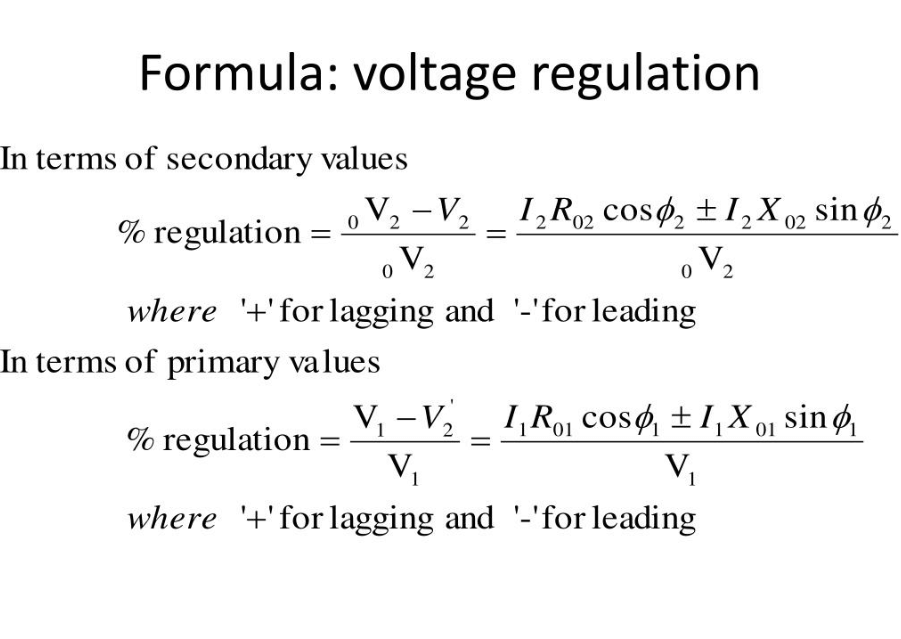
Figure 1: Voltage Regulation Formula
The Formula for Voltage Regulation
Voltage regulation in power transformers is key for maintaining stable output voltage despite changing load conditions. The primary goal is to ensure that the secondary voltage remains consistent, even when the load current varies.
This consistency is achieved using a formula that calculates the voltage change from no-load to full-load, expressed as a percentage of the full-load voltage. This calculation is required as it demonstrates the transformer's ability to deliver stable voltage under different operational conditions.
The formula underscores the need for meticulous design and precise engineering in power systems. By optimizing voltage regulation, we can significantly reduce efficiency losses and improve system reliability. This is especially important in scenarios where even small voltage deviations can impact performance and safety.
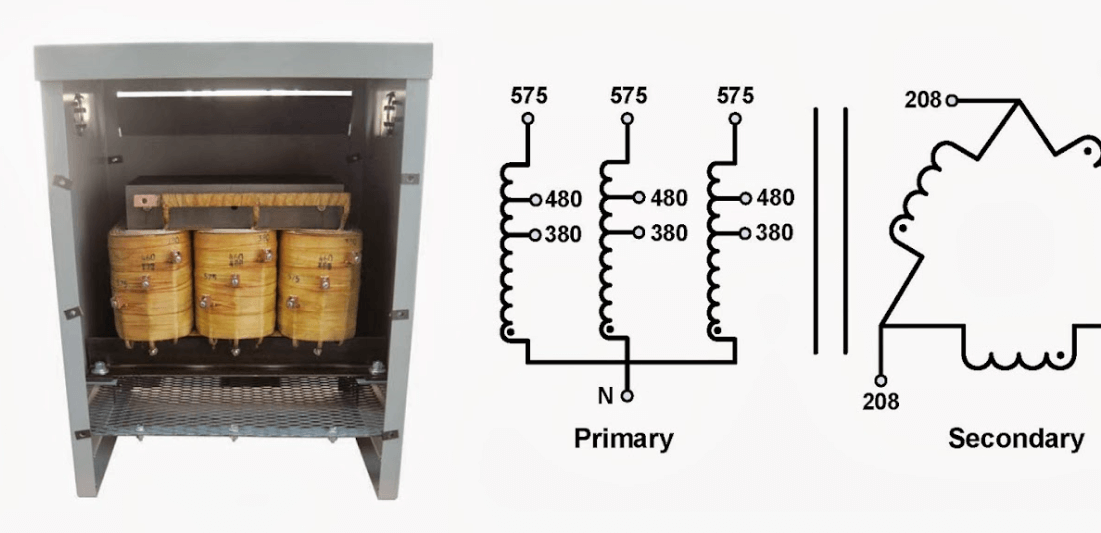
Figure 2: Full Load Transformers
Exploring "Full Load" Conditions in Transformers
"Full load" refers to the maximum capacity at which a transformer can operate without risking thermal damage or compromising safety. This capacity depends primarily on the size of the winding wires, which determines the maximum current the transformer can handle, and the efficiency of its cooling system, which prevents overheating and maintains thermal stability.
To demonstrate, using a SPICE-based simulation model can show how different load resistances affect the transformer's output voltage. This approach provides a clear view of its performance under various loading conditions.
Implications of Poor Voltage Regulation
In certain industrial and commercial settings, transformers are purposely designed to exhibit poor voltage regulation. This feature is useful for systems like discharge lighting and AC arc welding, where specific voltage behaviors are required for optimal performance.
For discharge lighting systems, transformers are engineered to provide high initial voltages to ignite the lamps. After ignition, the lamps need a lower voltage even as the current draw increases. This voltage drop after ignition is settling for maintaining the lamp's stability and efficiency over time.
Similarly, in AC arc welding, transformers initially supply a high voltage to start the welding arc. Once the arc is established, a significant voltage drop is needed to sustain it effectively. This controlled reduction in voltage is useful for maintaining the arc’s stability and ensuring consistent welding performance.
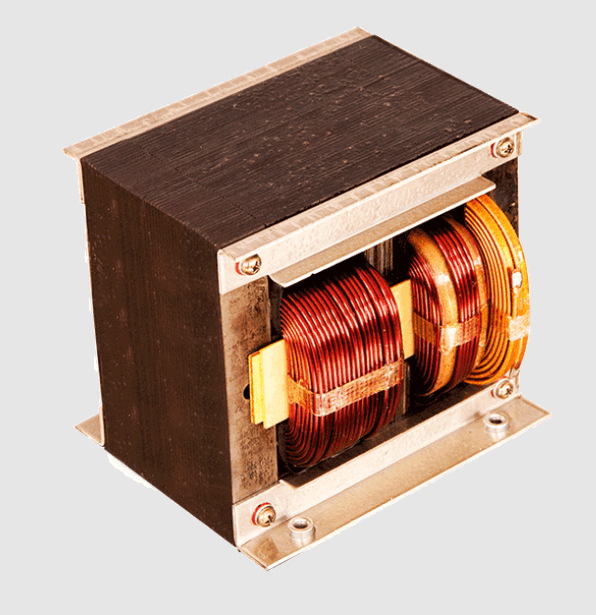
Figure 3: Ferroresonant Transformers
Operations of Ferroresonant Transformers
A ferroresonant transformer is designed to stabilize output voltages despite variable input conditions by utilizing the principle of ferroresonance. This involves operating the transformer core near magnetic saturation. When the core is close to saturation, its magnetic properties ensure that small variations in input current do not significantly impact the magnetic flux. Consequently, the output voltage remains stable.
Sensitive electrical devices and requisite data systems are two examples of applications where this steady output requires a steady and accurate voltage. Ferroresonant transformers achieve this by keeping their core in a saturated state for most of the AC cycle. This careful maintenance of saturation ensures a reliable and steady output voltage, protecting against fluctuations that could disrupt sensitive operations.
The operation of a ferroresonant transformer involves intricate interactions between its windings and the magnetic properties of the iron core. Engineers must precisely calibrate these transformers to optimize performance and ensure voltage stability. This makes ferroresonant transformers invaluable in situations where even minor voltage inconsistencies can cause significant operational issues.
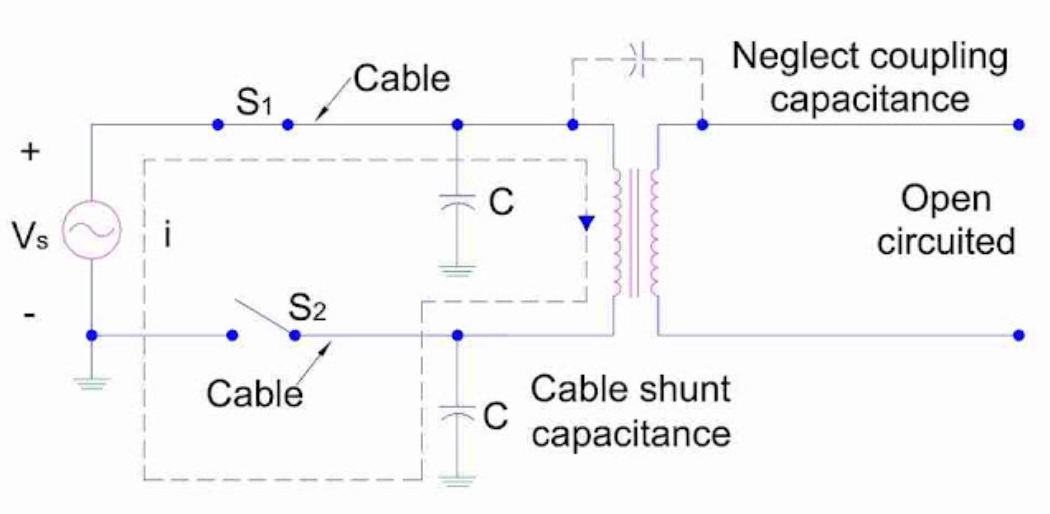
Figure 4: Resonance Circuits in Ferroresonant Transformers
Resonance Circuits in Ferroresonant Transformers
Ferroresonant transformers feature resonance circuits are a must for managing core saturation and improving output waveform quality. These circuits typically combine capacitors with extra windings to form a resonant, or "tank," circuit, finely tuned to the power supply's frequency. This configuration is required for energy storage as well as waveform stability.
The energy storage capability of the tank circuit allows the transformer to maintain output voltage during brief power interruptions. This guarantees a constant power supply, which makes sense for applications where even little disturbances might have negative effects. In addition, resonance circuits filter out harmonic distortions from the power output, resulting in a cleaner and more stable electricity supply.
Beyond simple voltage regulation, these circuits protect sensitive electronics from power quality issues like voltage spikes, dips, and noise. By integrating these resonance circuits, ferroresonant transformers offer a reliable solution for applications that demand consistent and high-quality power, enhancing the performance and lifespan of connected devices.
Drawbacks of Ferroresonant Transformers
While ferroresonant transformers are needed for stabilizing voltage in specific applications, they come with significant inefficiencies. One main issue is hysteresis losses within the saturated core, which generate considerable heat. This heat production requires additional cooling measures, complicating design and increasing operational costs.
Another drawback is their sensitivity to frequency variations. This sensitivity makes them less suitable for environments with power sources that have poor speed regulation, such as certain generators. As a result, their effectiveness in maintaining voltage stability is reduced under varying frequency conditions.
The resonance circuits in these transformers produce high voltages. Managing these high voltages necessitates expensive high-voltage capacitors, which add to the overall cost and complexity of the system. These high voltages also pose safety risks during maintenance, requiring stringent safety protocols and specialized equipment to protect personnel.
Insights into Transformer Voltage Regulation
Transformer voltage regulation is basic for controlling how transformers handle electrical loads, which affects the stability of the output voltage. Normally, a transformer provides its highest voltage output when it is not loaded, avoiding any losses caused by the load itself. Once a load is applied, the secondary winding sees a voltage drop. This drop occurs because the load induces currents that generate losses, mainly in the form of heat, within the windings. The extent of these effects is usually measured as a percentage or ratio, giving a precise indication of how a transformer performs under different loading conditions.
When a load is applied, it creates secondary currents that lead to resistive heating losses, lowering the output voltage. This reduction varies not only with the size of the load but also with its power factor. For instance, a load with a leading power factor might increase the secondary terminal voltage, while one with a lagging power factor generally reduces it. Considering these dynamics is needed for designing systems that can effectively compensate for these voltage changes, ensuring reliable and efficient power distribution in various settings.
For industrial automation, including Programmable Logic Controllers (PLCs), strict voltage regulation is a must. It ensures that operations are accurate and reliable. This regulation helps avoid production errors and potential damage to machinery. In the aerospace industry, voltage regulation is even more needed. It guarantees the reliability and seamless performance of avionics and spacecraft systems, which face extreme environmental conditions. This is key to ensuring safety and the success of missions.

Figure 5: Voltage Regulation on Transmission Lines
Managing Voltage Regulation on Transmission Lines
Voltage regulation is settling for efficient and reliable electricity delivery across power networks. Transmission lines have inherent resistance and reactance, causing voltage drops when under load. These drops can significantly affect the power quality received by end-users. To minimize these issues, engineers focus on reducing resistive losses and phase shifts. This involves making sophisticated design choices to optimize the physical and electrical properties of the lines, ensuring voltage stability from generation to consumption.
Design of Voltage Regulator Circuits
To maintain a constant output voltage in electrical systems, voltage regulator circuits are required, even in the presence of load variations or input voltage fluctuations. For electronics like microprocessors and delicate electrical components that need a steady voltage, these circuits guarantee operating stability. Voltage regulators are categorized into two main types: linear regulators and switching regulators. Each serves different applications based on their operational characteristics and efficiency.
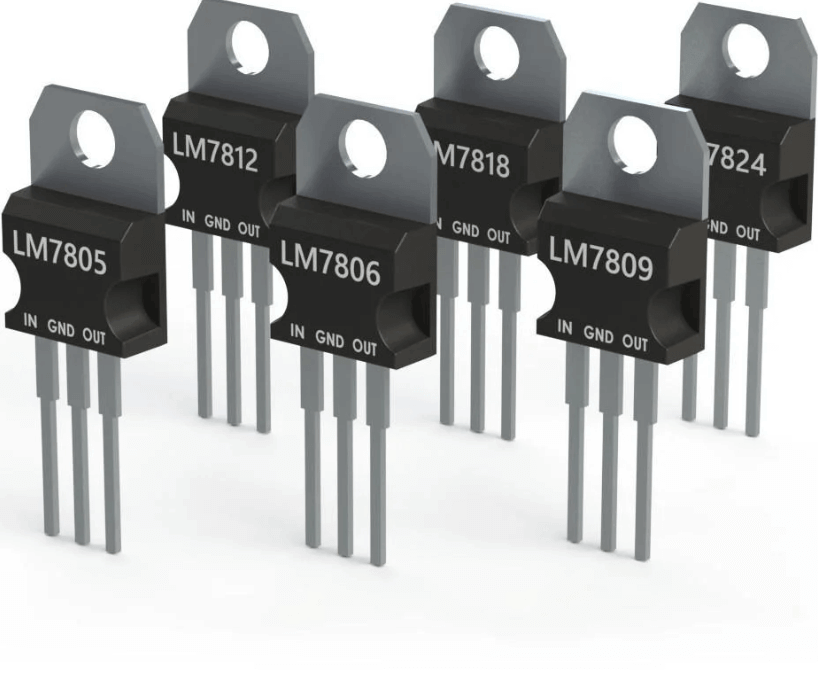
Figure 6: Linear Regulators
Linear Regulators
Linear regulators maintain voltage stability using a high-gain amplifier to control a pass device, such as a MOSFET or BJT. This pass device dynamically adjusts its resistance to stabilize the output voltage. Linear regulators are straightforward in design, making them easy to implement and reliable in noise-sensitive applications where signal integrity is needed. However, they are less efficient, especially with high voltage differentials, due to significant power dissipation as heat when the input-output voltage difference is large.

Figure 7: Switching Regulators
Switching Regulators
Switching regulators achieve higher efficiency through a more complex process. They regulate voltage by rapidly switching the input power on and off, using time-controlled switches and energy storage elements like inductors and capacitors. This technique allows precise adjustment of the output voltage by modulating the switch's duty cycle. Switching regulators are versatile; they can step up, step down, or invert input voltage, making them suitable for a wide range of applications. Despite their complexity and potential to introduce electrical noise—issues that require careful design to address—their superior efficiency and adaptability make them useful in modern electronics.
Challenges with Voltage Regulators
Voltage regulators are significant for maintaining stable power in electronic devices. However, they have inherent limitations that can impact their effectiveness in certain applications.
Linear regulators are known for their simplicity. On the other hand, they are inefficient when there's a large voltage difference between the input and output. In such cases, they dissipate a lot of power as heat, which not only wastes energy but also requires effective heat management to prevent thermal damage to the regulator and nearby components. This inefficiency is particularly problematic in applications were saving power or reducing device size is a must.
Switching regulators are more efficient over a wide range of input and output voltages. However, they are more complex and expensive to design and build. This complexity comes from the need for extra components like inductors, capacitors, and advanced control circuits to manage the switching operations. The rapid switching generates electromagnetic interference (EMI) and noise, which can interfere with nearby sensitive electronics. To address this, careful circuit layout and additional filtering components are required, adding to the overall complexity and cost of the system.
Various Methods of Voltage Regulation

Figure 8: Line Regulation
Line Regulation: Line regulation deals with maintaining a stable output voltage despite variations in the input voltage. This is key for ensuring that changes in the power supply do not affect the circuit's performance. When the input voltage fluctuates, line regulation adjusts to keep the output steady.

Figure 9: Load Regulation
Load Regulation: Load regulation maintains a stable output voltage as the load demands change. This is important for preventing performance issues when the connected loads vary. Load regulation ensures the output voltage remains constant, regardless of how much power the connected devices draw.
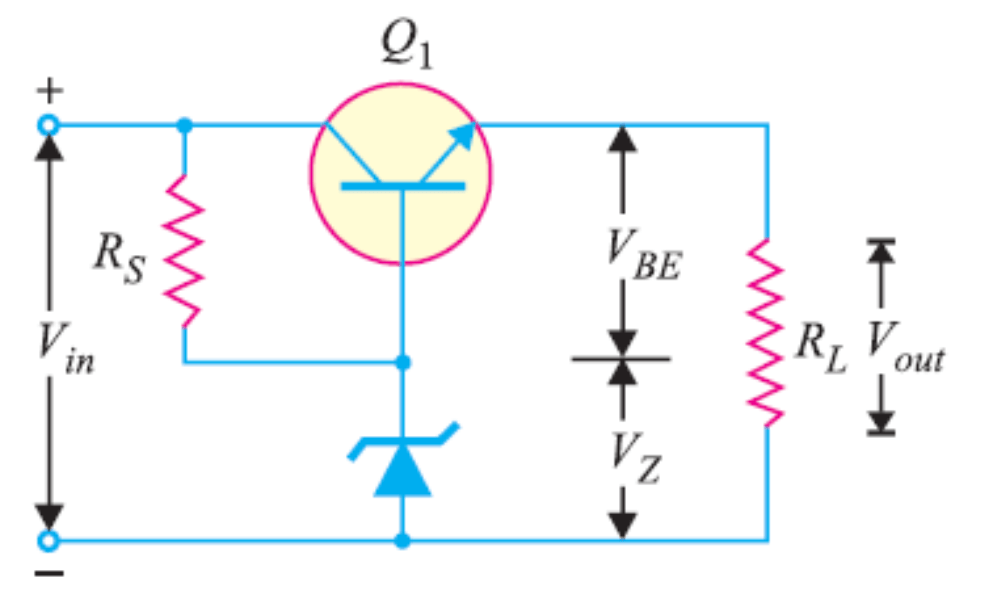
Figure 10: Series Regulators
Series Regulators: Series regulators manage output voltage by inserting a variable resistor in series with the load. By varying the resistance based on the load and input changes, they provide precise control over the output voltage. This makes them highly effective for applications requiring a stable and controlled output.

Figure 11: Shunt Regulators
Shunt Regulators: Shunt regulators work by diverting excess current away from the load to maintain a constant voltage. They shunt the current to the ground, which helps keep the voltage across the load steady. This method is particularly useful in applications where simplicity and cost-effectiveness are important.
Pros and Cons of Voltage Regulation
Because of their simple design, linear regulators are dependable and simple to use in noise-sensitive applications where signal integrity is required. But when the input-output voltage differential is huge, they lose a lot of power as heat, which makes them less efficient, especially at high voltage differentials.
Pros
Consistent Output: Voltage regulators provide a steady output, which is essential for the reliable operation of electronic equipment.
Device Protection: By maintaining stable voltage levels, voltage regulators help prevent damage to sensitive components.
Optimal Performance: Consistent voltage ensures that devices operate at their best, minimizing the risk of performance issues and data loss.
Longevity: A stable power supply contributes to the longer operational life of electronic components.
Cons
High Costs: Implementing voltage regulation can be expensive due to the initial setup costs and ongoing energy expenses.
Heat Generation: Voltage regulators often produce significant heat, requiring effective heat management solutions to prevent overheating.
Minimum Input Voltage Requirement: These systems need a minimum input voltage to function properly, limiting their use in situations with consistently low input voltage.
Key Properties and Features of Voltage Regulation
• Voltage Tolerance
Defines the acceptable range of voltage fluctuations. Ensures device integrity and consistent performance in different environments. Dangerous for maintaining stable operation despite variations in input voltage.
• Line Regulation
Maintains stable output voltage despite changes in input voltage. Protects electronics from power inconsistencies that could lead to malfunctions or damage. Requisite for systems that operate under varying power supply conditions.
• Ripple Rejection
Filters out AC ripple and electronic noise, ensuring a clean and stable DC output. Needed in environments with significant electronic interference.
• Transient Response
Measures how fast the regulator adapts to sudden changes in load or input voltage. Quickly stabilizes the output within safe limits to protect equipment. Important for applications with rapidly changing power demands.
• Efficiency
Ratio of output power to input power, indicating minimal energy loss. High efficiency leads to lower operating costs and reduced heat generation. Extends the lifespan of both the voltage regulator and the devices it powers.
• Protection of Sensitive Equipment
Voltage regulation helps ensure that sensitive electronic equipment maintains a constant output despite input voltage variations. This stability protects the equipment, prolongs component life, and minimizes the risk of data loss.
• Sustained Peak Performance
Robust voltage regulation helps shield delicate circuits from fluctuations, maintaining their functionality over time. This ensures that devices operate at their best, regardless of external power conditions.
The Various Applications of Voltage Regulation
In numerous fields, voltage control exists to provide efficiency and stability, which are key for the functionality and longevity of electronics. Voltage regulators play a key role in power supply systems. They are used in a wide range of devices from personal computers and household electronics to large appliances, providing a steady and constant voltage. This stable power supply helps maintain high performance and prolongs the lifespan of electronic components.
In the automotive industry, effective voltage regulation is a must. It helps ensure that electronic systems, such as engine control units and infotainment systems, function smoothly without interruptions caused by voltage fluctuations.
Voltage regulation and the dependability of communication equipment belong to the telecom industry's capacity to provide continuous service. Power fluctuations that could otherwise compromise signal integrity and reduce system performance are avoided by using proper voltage regulation. Precise voltage management is a must in the medical industry.
Conclusion
Throughout this exploration of voltage regulation, it becomes evident that the ability to control and stabilize voltage is not just a technical necessity but an ultimate enabler of modern electrical systems and infrastructure. From ensuring the safety and efficiency of transformers at full load to refining the performance of ferroresonant transformers in delicate applications, the principles discussed underscore the intricate balance required between power stability and system efficiency.
In addition, the detailed insights into voltage regulator circuits highlight their serious role in safeguarding and optimizing the functionality of electronic components across various sectors, including automotive, telecom, and medical industries. As we continue to push the boundaries of technology and demand more from our electrical systems, the evolution of voltage regulation techniques will play a significant role in enabling the next generation of power distribution and electronic design. Ultimately, this article not only sheds light on the technical intricacies of voltage regulation but also illustrates its profound impact on the reliability, efficiency, and advancement of electrical and electronic systems worldwide.
Frequently Asked Questions [FAQ]
1. Why is voltage regulation necessary?
Voltage regulation is essential because it ensures that electrical appliances and equipment receive a stable voltage, regardless of variations in the load or supply voltage. Stable voltage is crucial for the safety and efficient operation of electrical devices, preventing damage due to voltage fluctuations and enhancing performance and lifespan.
2. Why is a voltage regulator used?
A voltage regulator is used to maintain a constant voltage level automatically. It compensates for fluctuations in the supply voltage and changes in load, providing a stable output voltage to devices. This helps in avoiding issues like overheating, underperformance, or failure of electrical equipment.
3. What is the law of voltage regulation?
The law of voltage regulation states that the regulation efficiency is determined by the difference between no-load voltage and full-load voltage, expressed as a percentage of full-load voltage. This is calculated as:

4. What are the principles of voltage regulation?
The principles of voltage regulation involve controlling voltage through automatic adjustment mechanisms. These principles are typically based on feedback systems that detect voltage changes and make necessary adjustments to maintain a constant output. The regulation can be achieved through various technologies such as electromechanical mechanisms (like tap-changing transformers) or electronic methods (using semiconductor devices in linear or switching regulators).
5. What is the method of voltage regulation?
Methods of voltage regulation include:
Electromechanical regulation: Using devices like autotransformers or servo stabilizers that mechanically adjust transformer taps to regulate voltage.
Electronic regulation: Utilizing solid-state devices like transistors or thyristors to adjust voltage continuously. This includes linear regulators, which provide a steady and smooth output, and switching regulators, which are more efficient and adjust the voltage by switching the input on and off rapidly, controlling the energy provided to the load.
Feedback control systems: These systems measure the output voltage, compare it with a reference voltage, and adjust the input or change parameters to keep the output voltage within desired limits.